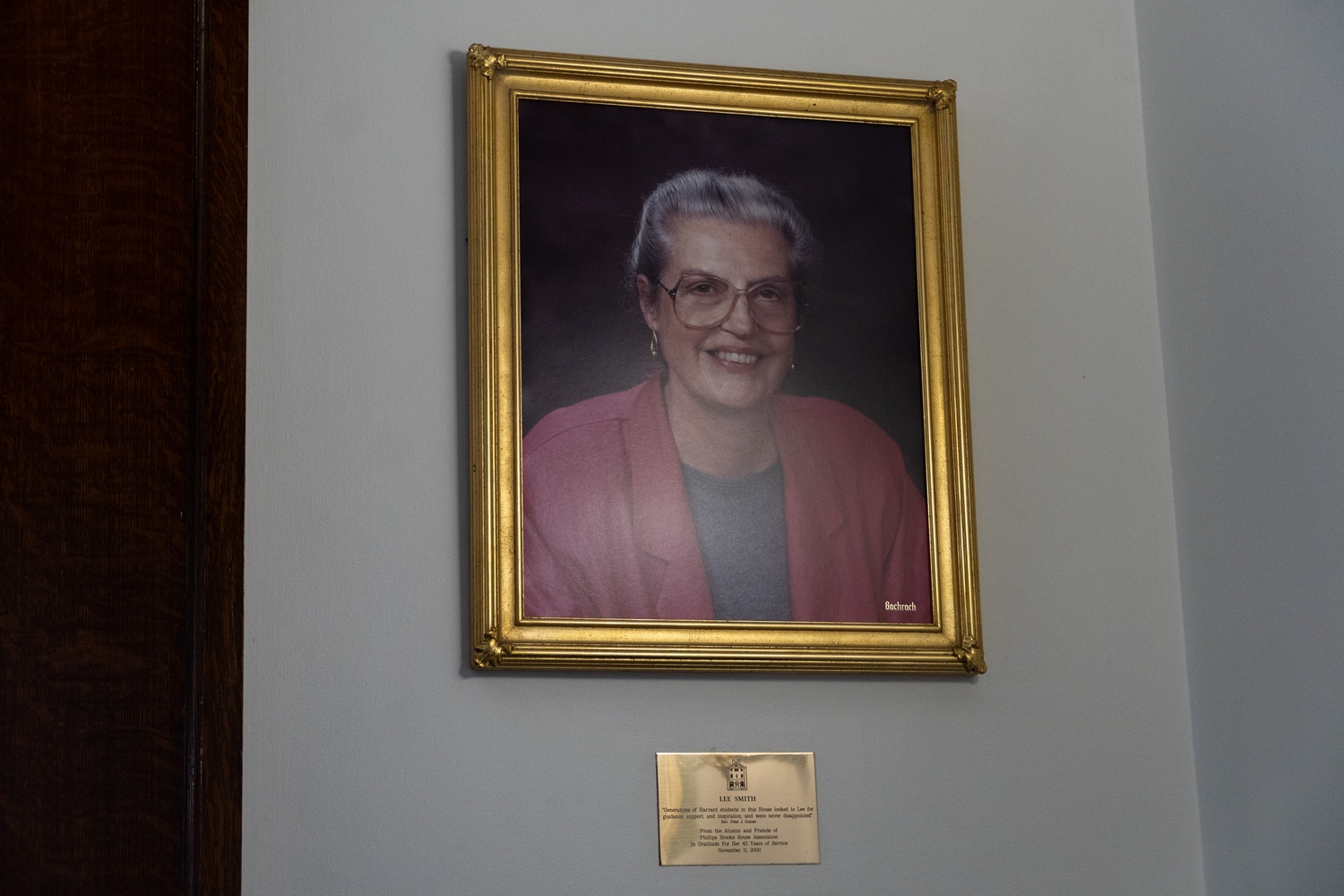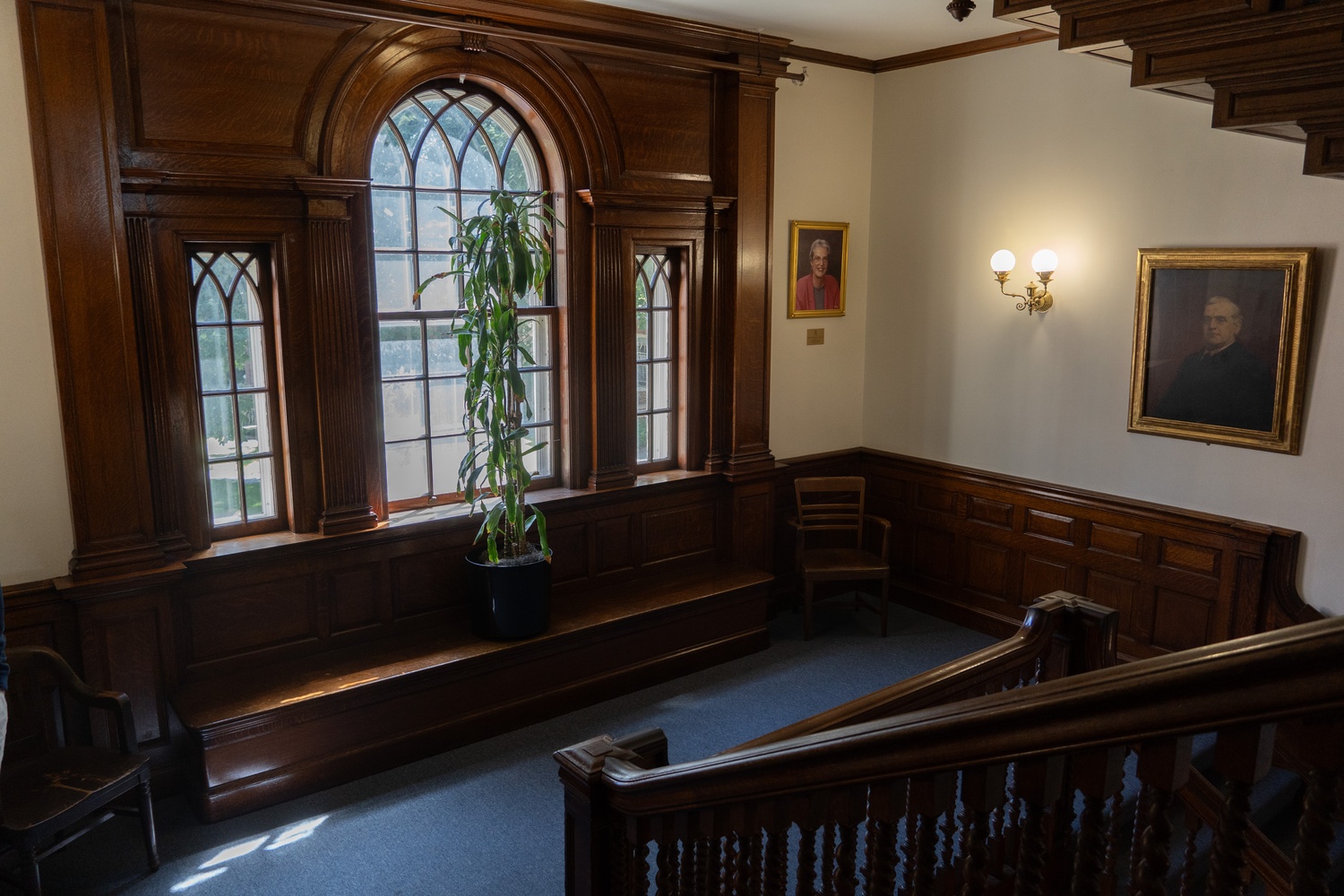‘The Rudder of the Organization’: Longtime PBHA Staff Member Lee Smith Remembered for Warmth and Intellect
Lee H. Smith, a longtime staff member at the Phillips Brooks House Association in Harvard Yard, died on June 19 in Burlington, Mass. She was 89.
Lee H. Smith, a longtime staff member at the Phillips Brooks House Association in Harvard Yard, died on June 19 in Burlington, Mass. She was 89.
Smith’s niece said that the cause of death was “natural causes.”
Smith first joined PBHA in 1957, intending to come on as a temporary worker for the fall semester. Instead, she stayed until her retirement in 2000 — capping off a 43-year-long career at the heart of Harvard’s hub for public service.
For many, Smith formed a role model and, at times, something close to a substitute parent known for both her warmth and steely competence in an organization run by students.
“She was really a constant for students across generations,” said Maria J. Dominguez Gray, the executive director of PBHA.
A Chance Encounter
Born in Boston on Feb. 3, 1935, Smith spent much of her early life in Pensacola, Fla. and Norfolk, Va. Her father, a commercial photographer, enlisted in the Navy after the outbreak of World War II. Soon after the war ended, her family returned to Massachusetts, eventually ending up in the Boston suburb of Wellesley.
After graduating from Wellesley High School and earning a junior college degree, Smith found work at a polio clinic at the Children’s Medical Center in Boston, now Boston Children’s Hospital. She served as a medical secretary there during Boston’s 1955 polio outbreak, which saw more than 2,000 cases in a single summer, overwhelming hospitals and emergency services.
“That was one of the best job training experiences I think anybody could have,” Smith said of her time at the Medical Center in a 2009 interview for a PBHA oral history project, where she recalled much of her early life and career. “That prepared me for most anything.”
In 1957, Smith left the Children’s Medical Center. She made the trek to Cambridge later that year, interviewing for a handful of jobs at Harvard.
But it was only by accident that she found Phillips Brooks House, where she would spend the remainder of her professional career. While walking across Harvard Yard to a job interview, Smith tried to cut through PBH as a shortcut, she recalled in the oral history.
As she entered, someone called out to her from an office right next to the entrance: a former colleague from the Children’s Medical Center, now working as an administrative assistant at PBH. As the two started talking, Smith learned that her former colleague was leaving her job.
She asked Smith to replace her. Smith eventually agreed, but on the condition that she be able to resign by the end of the semester.
Smith wouldn’t leave until her retirement more than four decades later.

‘Everything Was Under Control’
As a staffer at PBH, Smith formed a near-constant presence for thousands who passed through the building — from one-off volunteers to board members and student presidents.
David W. Moskowitz ’74, who volunteered at PBH’s Family Aid program, recalled Lee as a “no-nonsense person” whose presence was crucial to PBH’s operations.
“Lee Smith was salt of the earth, and she actually made these programs run, and she supported the kids,” he said. “I don’t think she bought bullshit. She certainly didn’t manufacture it.”
“She was, for me, evidence of what’s good and true about Harvard,” Moskowitz added.
Adair Dammann ’79 described Smith as “the rudder of the organization” who was vital to PHBA’s success over decades.
“Like everyone, I had total respect for her competence, her smarts,” she said. “Everything was under control.”
Smith was uniquely tuned to everything happening at PBHA, said Rosa Brooks ’91, a former president of PBHA.
“She knew which programs were flailing and which were healthy and strong,” Brooks said.
But Smith’s devotion to, and knowledge of, the going-ons of PBH extended beyond its programs, according to Brooks.
“She knew all the gossip,” Brooks said.
Still, for all of Smith’s seriousness, she was equally remembered for her warmth and humor, recalled Walter W. Birge III ’61, who entered Harvard the same year as Smith.
“She was incredibly warm. She was fun. She was quite funny,” Birge said. “She was a joy to be around.”
Outside of PBHA, Smith was known to dote on her two nieces. She never married and was preceded in death by her life partner, Rodney Duane.
“She was very present in our lives growing up,” said Kristen A. Anderson, Smith’s niece. Anderson recalled how Smith often hosted her nieces for sleepovers and bought them presents wrapped in newspaper comic pages.
But even more than physical gifts, Smith was known to “share an experience,” according to Anderson, traveling with her nieces to New York and Philadelphia for their birthdays and taking them to Hasty Pudding plays.
Smith also encouraged them to always try to meet new people, drawing from her own experiences.
“She said she could go to any continent and she’d know somebody, because of how many people she’d spoken to,” Anderson said. “As we got older, we realized how important that was.”
‘The Center of the Universe’
For many at PBH, Smith was a rare symbol of constancy — at times maternal, at times stern, but always positive — at a university that was ever-changing.
“You walked in the door, and her desk was on the ground floor,” said Douglas M. Schmidt ’76, who would stay friends with Smith in the decades after graduation. “It was kind of the center of the universe.”
For Tamara V. Tai ’98, a first-generation student, PBH was a “refuge on campus” — and Smith was a fixture of that refuge.
“Everything just felt so big,” Tai said. “And Lee just felt so down to Earth. She felt really humble, funny.”
“Lee was the dorm mother, if you will, of PBH,” she added. “I never felt any connections to any of my dorm tutors. But I felt connected to Lee.”

From her office in PBH, tucked into a corner of Harvard Yard, Smith witnessed some of Harvard’s most transformative periods.
She was more than a decade into her work at PBH when Vietnam protests engulfed campus, even helping University administrators — wary of an impending occupation of University Hall by student protesters — safeguard vital documents at PBH.
By the time she retired in 2000, the University had been completely transformed from the Harvard she first entered in 1957. Harvard and Radcliffe had merged, granting men and women the same degrees. Five new Houses had been added, bringing the total number to 12. A campus once confined to the Square had grown into Boston and beyond.
Smith had seen it all, and more, from her office in the corner of Harvard Yard.
Smith enjoyed recounting stories of her time at Harvard even as she neared retirement, according to Gray, the PBHA executive director.
As PBHA embarked on an ambitious transition throughout the 1990s and the turn of the century — including a restructured student board and a large-scale capital campaign — Smith became a source of deep-seated institutional memory.
“I can picture sitting with her on the back porch of PBH, and her just telling these stories after stories,” Gray said.
“She cared so deeply about these stories, and she had an incredible memory and she was able to connect the dots across time,” Gray added.
Smith began experiencing memory loss several years before her death. Yet, even at the end of her life, she remained tied to her time at PBHA.
“I would always bring up Harvard. I would always bring up Phillips Brooks House. And it was the one thing that I could keep saying to her that she could tap into, in her past,” Anderson said. “It’s the one thing that was ingrained in her heart and her soul that she could pull out.”
—Alma T. Barak contributed reporting.
—Staff writer Matan H. Josephy can be reached at matan.josephy@thecrimson.com. Follow him on X @matanjosephy.
